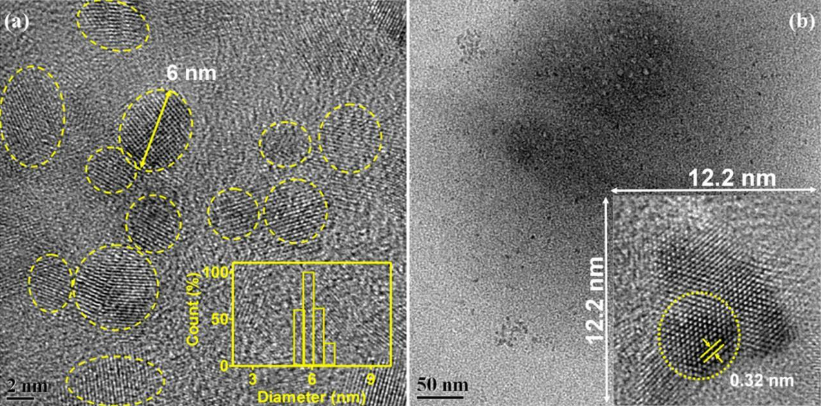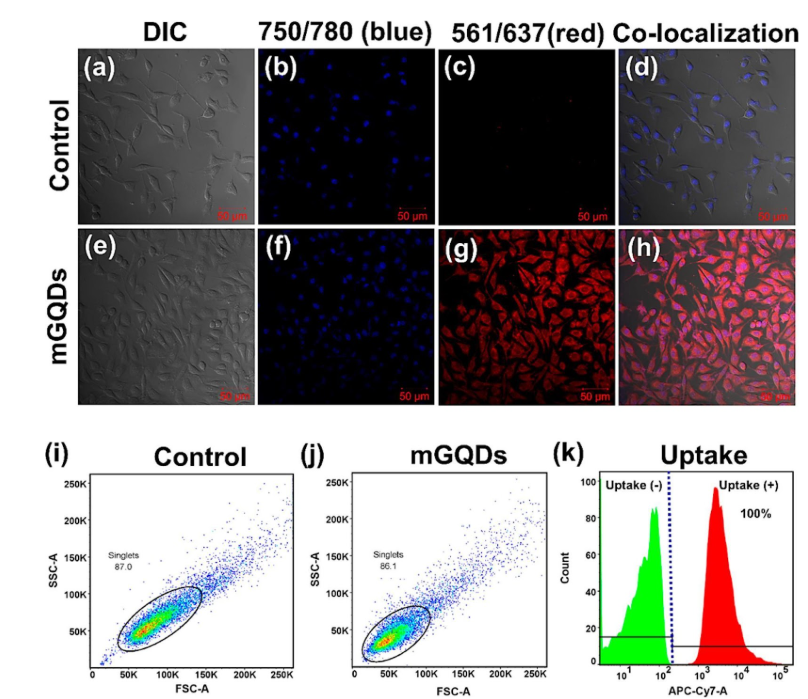The present invention relates to red luminescent carbon nanostructures particularly graphene quantum dots using Mangifera indica (mango) as carbon source for biomedical applications such as near infrared, bioimaging, intracellular and temperature sensors. The present invention further relates to a process for the synthesis of red luminescent carbon nanostructures. More particularly, the present invention relates to a one-pot process for the synthesis of red luminescent graphene quantum dots (GQDs) using Mangifera indica as a carbon source.
Figure (1) FEG-TEM micrograph of mGQDs (1a) Yellow highlighted individual mGQDs and inset shows size distribution characterization using DLS, (1b) TEM micrograph showing mGQDs at 50 nm scale with an inset showing a frame with dimension of 12.2 x 12.2 nm displaying high-resolution image; Figure (2) Bioimaging and cellular uptake studies of L929 cells treated with mGQDs after 24 h, (2a–2d) Control (untreated) cells show only DAPI-stained nuclei with no emission in NIR region. However, cells labeled with both DAPI and mGQDs (2e–2h) show clear NIR signal in the cell cytoplasm. The excitation/emission wavelengths used for DAPI and mGQDs were 750/780 nm and 561/637 nm, respectively. (2i–2j) Cellular uptake was performed using flow cytometry showing 100% cell uptake as compared to untreated control cells. Publication: Kumawat, Mukesh Kumar, et al. "Graphene quantum dots from mangifera indica: application in near-infrared bioimaging and intracellular nanothermometry." ACS Sustainable Chemistry & Engineering 5.2 (2017): 1382-1391.
Existing methods for synthesizing graphene quantum dots (GQDs) often rely on toxic chemicals, high temperatures, and complex procedures, resulting in materials with limited biocompatibility and poor near-infrared (NIR) fluorescence. Furthermore, few GQDs enable efficient NIR bioimaging and intracellular temperature sensing, which are critical for advanced biomedical applications.
- Red/NIR Fluorescence and Temperature Sensing: The mGQDs emit strongly in the near-infrared (NIR) region, making them highly effective for deep-tissue bioimaging. It is also capable of precise temperature sensing in live cells, enabling non-invasive monitoring of intracellular conditions.
- High Biocompatibility and Low Toxicity: The mGDQs Synthesized from metal-free natural precursors, the mGQDs do not require external capping agents or passivation to make them biocompatible and stable.
- Tunable Surface Functionality: Surface modification of mGQDs can tune the fluorescence emission realizing its potential toward in vivo bioimaging. Furthermore, mGQD shows good resolution over the wide temperature range in vitro.
- Photostable and Excellent Cellular Uptake: The nanodots show high photostability and efficient internalization in live cells, enabling reliable and long-duration imaging.
NA
Technology synthesized, developed and tested for NIR fluorescence and thermometry applications till proof-of-concept.
3
This invention promotes green nanotechnology by utilizing mango leaves—a renewable bio-waste—as a carbon source, reducing dependence on toxic chemicals and expensive materials. The resulting biocompatible mGQDs enable non-invasive biomedical imaging and intracellular temperature sensing, advancing early disease detection and monitoring. With its scalable and eco-friendly synthesis, the technology supports sustainable healthcare innovation and could significantly reduce costs in diagnostics, benefiting both medical systems and underserved communities.
- Biomedical Imaging
- Diagnostics and Nanomedicine
- Pharmaceuticals
- Biotechnology
- Healthcare Devices
- Green Nanotechnology
- Bio-sensing Equipment
Geography of IP
Type of IP
201721016198
441550


